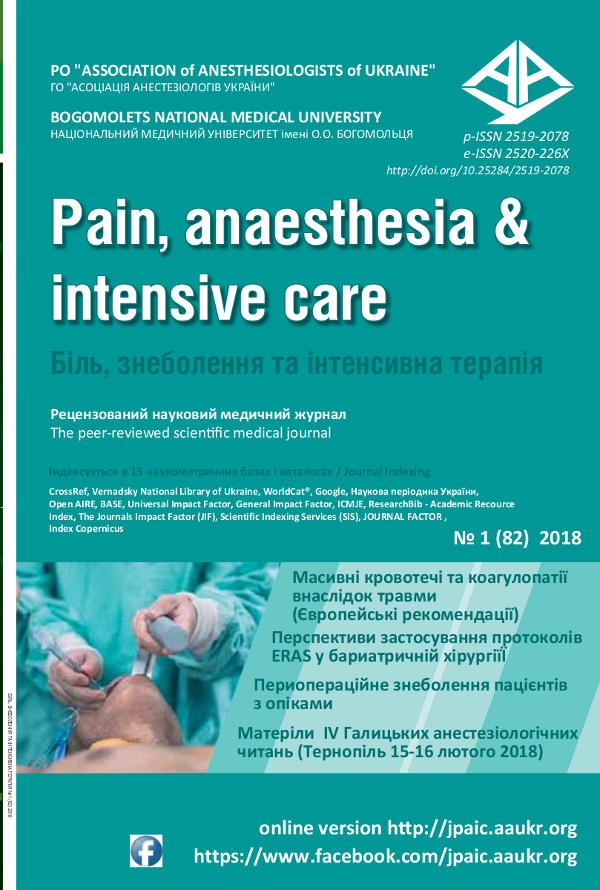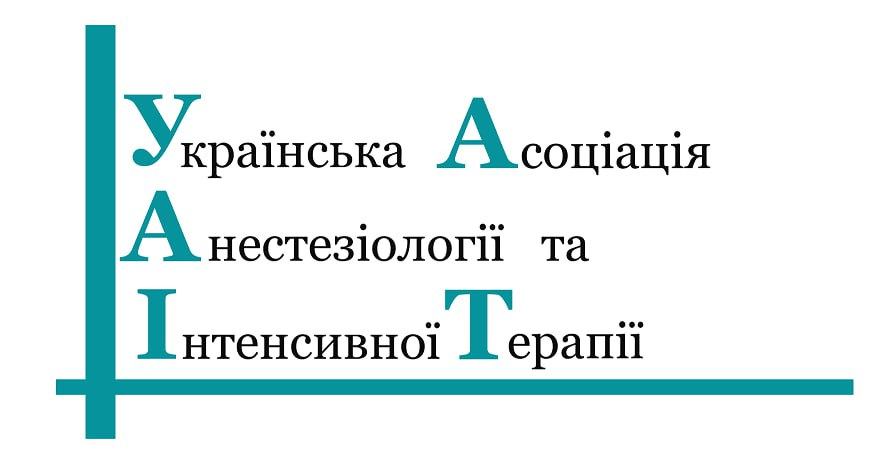Перспективи застосування протоколів eras у бариатричній хірургії
DOI:
https://doi.org/10.25284/2519-2078.1(82).2018.121954Ключові слова:
баріатрична хірургія, прискорена реабілітація, ожирінняАнотація
Метою роботи є зібрати в єдине ціле розрізнену інформацію, присвячену окремим аспектам застосування методик ERAS, для створення проекту україномовних рекомендацій щодо оптимізації ведення пери операційного періоду у баріатричних пацієнтів.
Матеріали та методи. Запропоновані рекомендації засновані на даних, отриманих з рандомізованих досліджень і мета-аналізів, присвячених вивченню різних проблем, в першу чергу, в популяції баріатричних пацієнтів, а при недоступності відомостей для пацієнтів з морбідним ожирінням – у загальнохірургічних пацієнтів.
Недавні результати. Протоколи прискореної реабілітації після операції (Enhanced Recovery After Surgery – ERAS) широко використовуються в різних галузях хирургїі, принципово змінивши підхід до периопераційного ведення хірургічних пацієнтів. Протоколи ERAS фактично охоплюють розширені перед-, інтра- та післяопераційний періоди. У статті наведено огляд сучасних даних про методи прискореної реабілітації, які застосовуються в баріатричній хірургії. Методи прискореної реабілітаці ї можуть використовуватися для оптимізації всіх етапів периопераційного ведення пацієнта і включають дані про підготовку до операції, підтримці електролітного балансу, профілактику післяопераційної нудоти і блювоти, адекватної аналгезії, а також визначаються критерії безпечної виписки пацієнта зі стаціонару.
Заключеня. Протоколи ERAS успішно використовуються у пацієнтів з ожирінням після баріатричних хірургічних втручань, а принципи мультимодальной аналгезії зводять до мінімуму потребу в опіоїдах. Принципи ERAS вже виправдали себе в багатьох клініках і повинні знайти відображення в Національних клінічних рекомендаціях по баріатричній хірургії.
Посилання
Kehlet H. Multimodal approach to control postoperative pathophysiology and rehabilit ation. Br J Anaesth. 1997;78(5): 606 – 17.
 |
|  |
| 
Greco M, Capretti G, Beretta L, et al. Enhanced recovery program in colorectal sur gery: a meta-analysis of randomized controlled trials. World J Surg. 2014 Jun;38(6):1531-41. doi: 10.1007/s00268-013-2416-8.
Melnyk M, Casey RG, Black P, et al. Enhanced recovery after surgery (ERAS) protocols: time to change practice? Can Urol Assoc J. 2011;5(5):342–8
Lemanu DP, Srinivasa S, Sing h PP, Johannsen S, MacCormick AD, Hill AG. Optimizing perioperative care in Bariatric Surgery patients.OBES SURG 2012;22(6):979–990. doi: 10.1007/s11695-012-0648-6.
 |
| 
Jung B, Pahlman L, Nystro m PO, et al. Multicentre randomized clinical trial of mechanical bowel preparation in elective colonic resection. The British journal of surgery 2007;94(6):689–695. doi: 10.1002/bjs.5816
 |
| 
Bundgaardnielsen M, Secher NH, Kehlet H. ‘Liberal’ vs. ‘restrictive’ perioperative fluid therapy – a critical assessment of the evidenc e. Acta Anaesthesiologica Scandinavica 2009;53(7): 843–851. PMID: 19519723. doi: 10.1111/j.1399 -6576.2009.02029.x.
 |
| 
Carrure N, Seulin P, Julio CH, Bloom E, Gouzi J, Pradure B. Is Nasogastric or Nasojejunal Decompression Necessary after Gastrectomy? A Prospective Randomized Trial. World J. Surg 2007;31(1):122–127 .doi: 10.1007/s00268-006-0430-9.
 |
| 
Kavuturu S, Rogers AM, Haluck RS. Routine Drain Placement in Roux-en-Y Gastric Bypass: An Expanded Retrospective Comparative Study of 755 Patients and Review of the Literature. OBES SURG 2012;22(1):177–181. PMID: 22101852. doi: 10.1007/s11695-011-0560-5.
 |
| 
Stelfox H. et al. Hemodynamic monitoring in obese patients: the impact of body mass index on cardiac output and strock volume. Crit. Care Med. 2006; 34:1243–1246.
 |
| 
Mendes MN, Monteiro Rde S, Martins FA. Prophylaxis of postoperative nausea and vomiting in morbidly obese patients undergoing laparoscopic gastroplasties: a comparative study among three methods. Revista brasileira de anestesiologia 2009;59(5):570–576. PMID: 19784512.

Conor J. et al. Extended t hromboprophylaxis reduces incidence of postoperative venous thromboembolism in laparoscopic bariatric surger. Surg. Obes. Rel. Dis. 2010; 6:322–325.
 |
| 
Kehlet H. Fast-track surgery-the role of anaesthesiologist and perioperative pain man agement. Refresher course lectures. Munich. 2007; 153–155.
deFreitas DJ, Kasirajan K, Ricotta JJ, et al. Preoperative inpatient hospitalization and risk of perioperative infection following elective vascular procedures. Annals of vascular surgery 2012;26(1):46–5 4. PMID: 22079458.doi: 10.1016/j.avsg.2011.08.008.
 |
| 
Noblett SE, Watson DS, Huong H, et al. Pre-operative oral carbohydrate loading in colorectal surgery: a randomized controlled trial. Colorectal disease: The official journal of the Association of Coloproctology of Great Britain and Ireland 2006; 8(7):563–569. PMID: 16919107. doi: 10.1111/j.1463-1318.2006.00965.x.
 |
| 
Nutescu E, Spinler S, Wittkowsky A, Dager WE. Low-molecular-weight heparins in renal impairment and obesity: available evidence and clinical practice recommendations across medical and surgical settings. Ann Pharmacother 2009; 43:1064–1083.
 |
| 
Shabanzadeh DM, Sшrensen LT. Laparoscopic Surgery Compared With Open Surgery Decreases Surgical Site Infection in Obese Pati ents. Annals of Surgery 2012;256(6):934–945. PMID : 23108128. doi: 10.1097/SLA.0b013e318269a46b
 |
| 
Wulf H. Combined epidural with general anaesthesia vs. General anaesthesia alone-in major abdominal surgery. XXYI annual ESRA congress; 2007 Sep 12–15; Valencia, Spain; 2007:238–239.
Fischer B. Benefits, risks, and best practice in regional anesthesia: do we have the evidence we need? Reg Anesth Pain Med 2010;35:545–8.
 |
| 
Volk T, Engelhardt L, Spies C, Steinfeldt T,Gruenewald D, Kutter B, Heller A, Werner C, Heid F, Burkle H, Gastmeier P, Wernecke KD, Koch T, Vicent O, Geiger P. Wulf H [Incidence of infection from catheter procedures for regional anesthesia: first results from the network of DGAI and BDA]. Anaesthesist 2009;58:1107–12.
 |
| 
Capdevila X, Bringuier S, Borgeat A. Infectious risk of continuous peripheral nerve blocks. Anesthesiology 2009; 110:182–8.
 |
| 
Brodsky J, Lemmens H. Anesthetic management of the obese surgical patient. Cambridge, 2012; 137 p.

Mahajan V, Hashmi J, Singh R, et al. Comparative evaluation of gastric pH and volume in morbidly obese and lean patients undergoing elective surgery and effect of aspiration prophylaxis. J Clin Anesth 2015;27:396–400.
 |
| 
Freid EB. The rapid sequence induction revisited: obesity and sleep apnea syndrome. Anesthesiol Clin North Am 2005; 23:551–564.
 |
| 
Perlas A, Chan VWS, Lupu CM, et al. Ultrasound assessment of gastric content and volume. Anesthesiology 2009;111:82–89.
 |
| 
Jean J, Compe‘ re V, Fourdr inier V, et al. The risk of pulmonary aspiration in patients after weight loss due to bariatric surgery. Anesth Analg 2008; 107:1257–1259.
 |
| 
Lemanu DP, Singh PP, Berr idge K, et al. Randomized clinical trial of enhanced recovery versus standard care after laparoscopic sleeve gastrectomy. Br J Surg 2013;100: 482–489.
 |
| 
Lemanu DP, Srinivasa S, Si ngh PP, et al. Optimizing perioperative care in bariatric surgery patients. Obes Surg 2012; 22:979–990.
 |
| 
Mansour M, Mahmoud AA, Geddawy M. Nonopioid versus opioid based general anesthesia technique for bariatric surgery: A randomized double-blind study. Saudi J Anaesth 2013;7(4):387–391. PMID: 24348288. doi: 10.4103/1658-354X.121045.
 |
| 
Gurusamy KS, Koti R, Davidson BR. Routine abdominal drainage versus no abdominal drainage for uncomplicated laparoscopic cholecystectomy. Cochrane Database Syst Rev. 2013;9. PMID: 24000011. doi: 10.1002/14651858.CD006004.pub4.
 |
| 
Kavuturu S, Rogers AM , Haluck RS . Routine Drain Placement in Roux-en-Y Gastric Bypass: An Expanded Retrospective Comparative Study of 755 Patients and Review of the Literature. OBES SURG 2012;22(1): 177–181. PMID: 22101852. doi: 10.1007/s11695-011-0560-5.
 |
| 
Chopra T, Marchaim D, Lynch Y, Kosmidis C, Zhao JJ, Dhar S, et al. Epidemiology and outcomes associated with surgical site infection following bariatric surgery. American Journal of Infection Control 2012;40(9):815–819. PMID: 22325729. doi: 10.1016/j.ajic.2011.10.015.
 |
| 
Ruiz Tovar J, Badia JM. Prevention of surgical site infection in abdominal surgery. A critical review of the evidence. Cir Esp 2014;92(4):223–231 . PMID: 24411561. doi: 10.1016/j.ciresp.2013.08.003.
 |
| 
Hafermann MJ, Namdar R, Seibold GE, Page RL, 2nd. Effect of intravenous on dansetron on QT interval prolongation in patients with cardiovascular disease and additional risk factors for torsades: a prospective, observational study. Drug, healthcare and patient safety. Drug, healthcare and patient safety 2011;3:53–58. doi: 10.2147/DHPS.S25623.
 |
| 
Schumann R. Anaesthesia for bariatric surgery. Best Practice & Research Clinical Anaesthesiology 2011;25(1):83–93. doi: 10.1016/j.bpa.2010.12.006.
 |
| 
Saravanakumar K, Rao SG, Cooper GM. Obesity and obstetric anaesthesia. Anaesthesia 2006;61(1):36–48. doi: 10.1111/j.1365-2044.2005.04433.x.
 |
| 
Dobesh PP, Wittkowsky AK, Stacy Z, Dager WE, Haines ST, Lopez LM, et al. Key Articles and Guidelines for the Prevention of Venous Thromboembolism. Pharmacotherapy 2009;29(4):410–458. doi: 10.1592/phco.29.4.410.
 |
| 
Kaffarnik M, Utzolino S. Postoperatives Management bei Patienten miteinem BMI>40 kg/m2. Zentralbl Chir 2009;134(01):43–49. doi: 10.1055/s-0028-1098806.
 |
| 
Kehlet H. Multimodal approach to postoperative recovery. Current Opinion in Critical Care 2009;15(4):355–358. doi: 10.1097/MCC.0b013e32832fbbe7.
 |
| 
Mechanick J I, Youdim A, Jones DB, Timothy Garvey, W, Hurley DL, Molly McMahon, M, et al. Clinical Practice Guidelines for the Perioperative Nutritional, Metabolic, and Nonsurgical Support of the Bariatric Surgery Patient - 2013 Update: Cosponsored by American Association of Clinical Endocrinologists, The Obesity Society, and American Society for Metab olic & Bariatric Surgery. Surgery for Obesity and Related Diseases 2013;9(2):159–191. doi: 10.1016/j.soard.2012.12.010.
 |
|  |
| 
Khatsiev B.B., Kuzminov A.N., Yashkov Yu.I., Uzdenov N.A. Enhanced recovery after bariatric surgery – a modern approach. Obesity and meta bolism. 2014; (4): 19-24.DOI: 10.14341/OMET2014419-24
##submission.downloads##
Опубліковано
Як цитувати
Номер
Розділ
Ліцензія
Авторське право (c) 2018 В. І. Черній, В. В. Євсєєва

Ця робота ліцензується відповідно до Creative Commons Attribution-NonCommercial 4.0 International License.
Автори, які публікуються у цьому журналі, погоджуються з наступними умовами:
a. Автори залишають за собою право на авторство своєї роботи та передають журналу право першої публікації цієї роботи на умовах ліцензії Creative Commons Attribution-NonCommercial 4.0 International License, котра дозволяє іншим особам вільно розповсюджувати опубліковану роботу з обов'язковим посиланням на авторів оригінальної роботи та першу публікацію роботи у цьому журналі.
b. Автори мають право укладати самостійні додаткові угоди щодо неексклюзивного розповсюдження роботи у тому вигляді, в якому вона була опублікована цим журналом (наприклад, розміщувати роботу в електронному сховищі установи або публікувати у складі монографії), за умови збереження посилання на першу публікацію роботи у цьому журналі.
c. Політика журналу дозволяє і заохочує розміщення авторами в мережі Інтернет (наприклад, у сховищах установ або на особистих веб-сайтах) рукопису роботи, як до подання цього рукопису до редакції, так і під час його редакційного опрацювання, оскільки це сприяє виникненню продуктивної наукової дискусії та позитивно позначається на оперативності та динаміці цитування опублікованої роботи (див. The Effect of Open Access).








